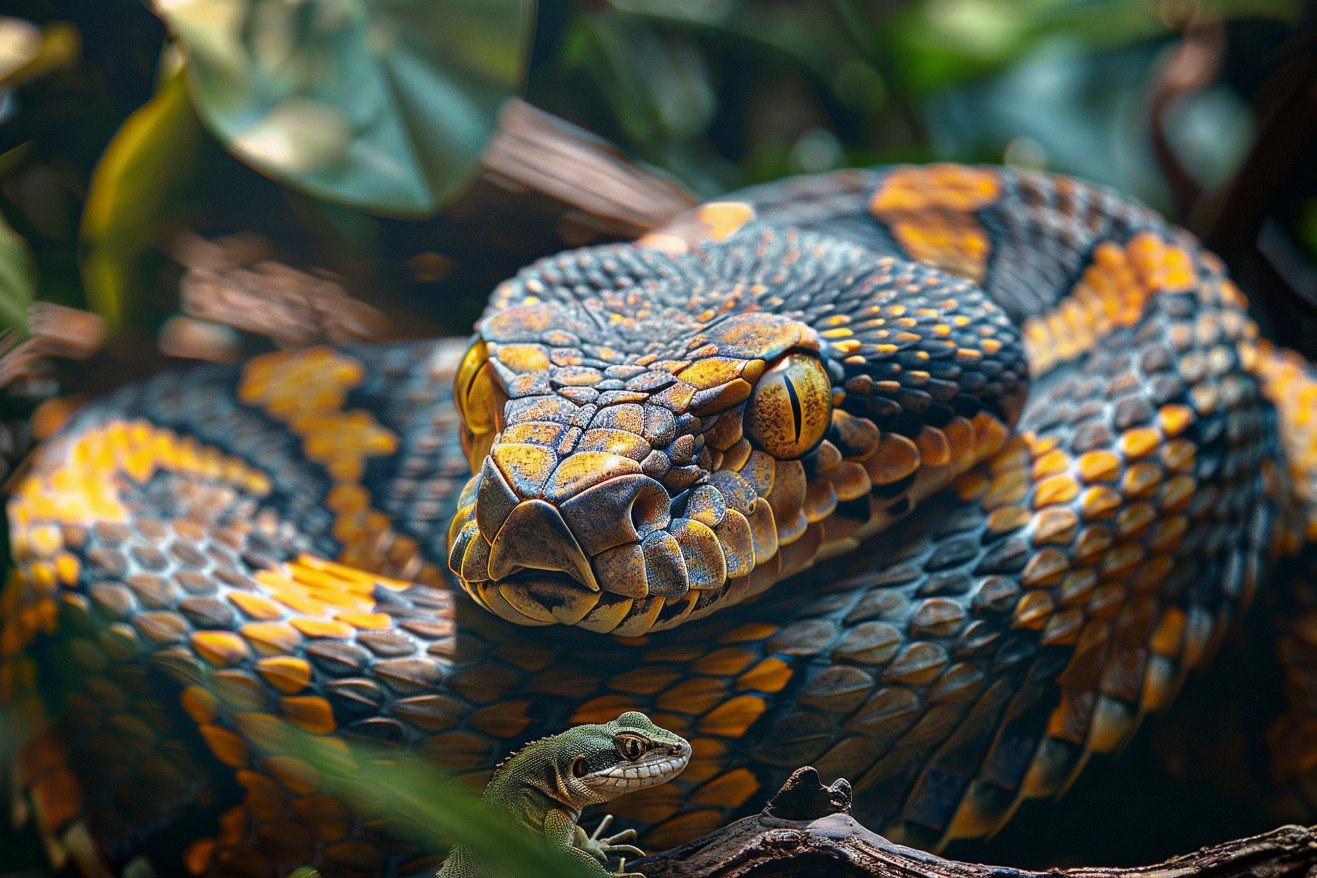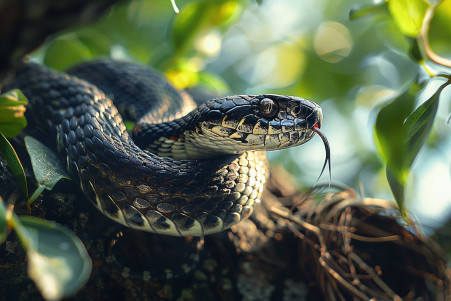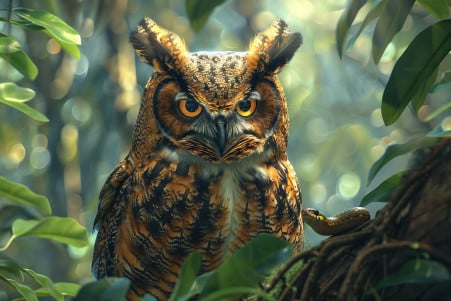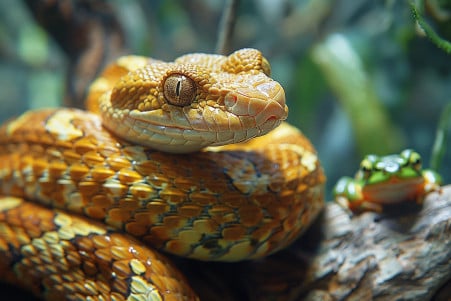What Do Snakes Eat? The Complex Relationship Between Snakes and Lizards
12 April 2024 • Updated 11 April 2024

This in-depth look at what snakes eat covers the complex relationship between snakes and one of their potential prey species—lizards. While some snakes primarily eat other animals like rodents or birds, there are many species of snakes that are active hunters of lizards, using their senses and quick reflexes to surprise their cold-blooded prey.
This article will use the latest scientific research to provide an in-depth look at the predator-prey relationship between different species of snakes and lizards in a variety of environments. Not only will this look at how snakes hunt but it will also examine the many ways that lizards have evolved to avoid their predators, providing a fascinating look at the many ways that survival plays out in the world of reptiles.
Do snakes eat lizards?
Specialized Snake Predators: Lizard-Eating Specialists
Some snake species have developed specialized predation strategies and anatomical features that enable them to successfully target and eat lizards. The dwarf crowned snake (Cacophis kreffti), a small venomous elapid, is a specialist lizard predator that constricts its prey while its venom takes effect, according to a study from the University of Melbourne. Some snakes, like the orange-naped snake, are even considered lizard specialists because they primarily eat skinks and other lizards.
A snake's mode of predation, either ambush or active foraging, also has a big impact on the lizards it encounters and eats. Venomous ambush predators, like most vipers, have stout bodies that are well-suited to waiting in ambush, while active foragers like many elapids have slender bodies that are better for chasing prey. As a paper from Oxford Academic explains, a snake's body size, venom toxicity, and jaw mobility all enable it to more effectively subdue, kill, and eat lizards of different sizes. For example, the diurnal, visually-oriented yellow-faced whip snake tends to eat large skinks, while the sedentary death adder is better at catching small, fast-moving lizards with its effective luring behavior.
Hunting Tactics and Prey Selection
Snakes use a variety of hunting tactics and prey selection methods when going after lizards, and these methods depend on the snake's size, environment, and the lizard's behavior. For example, the yellow-faced whip snake, which is a visual hunter, will chase after lizards it can see, while others will use chemical cues and scent trails to find their prey, according to a blog post from the University of Melbourne. Meanwhile, the presence of other food sources can also determine whether or not a snake will hunt lizards, with snakes opting for more available or easier to catch prey, according to a study from the National Institutes of Health.
Some snakes, like the orange-naped snake, are known as lizard specialists and will eat skinks and other lizards, even when they're young. However, as snakes get older, they may change their eating habits, starting with lizards and then moving on to larger warm-blooded prey like birds and mammals, according to the Merck Veterinary Manual. Meanwhile, a study published in PubMed showed that some lizards are able to kill and eat prey that's as big as they are, which challenges the idea that snakes are the only reptiles that have evolved to kill prey that's larger than they are.
Meanwhile, a lizard's ability to regenerate its tail, its size, and its activity levels can all determine how susceptible it is to different snake predators and their hunting methods, according to a Scientific American article that looks at the evolutionary biology of snakes. Understanding these relationships is important for learning more about the complex interactions between snakes and the lizards they eat.
Sensory Adaptations for Lizard Detection
Snakes have a number of sensory adaptations that help them find, recognize, and catch lizards. Snakes can detect vibrations and sound waves through the ground, which helps them locate lizards and other prey, according to ScienceDaily. Meanwhile, the vomeronasal organ, or Jacobson's organ, helps snakes detect the chemical scent trails that lizards leave behind, which helps them track their prey, according to the Britannica.
In addition, some snakes, including pit vipers and boas, have infrared-sensing pits that help them detect the body heat of warm-blooded prey, including lizards, according to the Britannica article. Although snakes have poor vision, their ability to detect movement and other senses make up for this when it comes to hunting lizards and other prey, according to Pets on Mom.com.
These adaptations help snakes find and recognize their lizard prey, even when their vision is limited by their environment. This ensures that the ongoing battle between these reptilian predators and their nimble lizard prey will continue.
Ecological Impacts and Lizard Defenses
The impact of snake predation on lizard populations can be far-reaching, affecting their abundance, size distribution, and even their behaviors. One investigation published by the National Institutes of Health showed that the removal of snake predators from an ecosystem resulted in an increase in lizard abundance and body sizes, providing evidence of the regulatory effect of snake predation.
In some cases, such as on islands where snake densities are high, lizards have evolved ways to defend against snake predation, particularly when it comes to protecting their young. For example, a study in Scientific Reports showed that on the Izu Islands, the lizard species Plestiodon latiscutatus has evolved maternal egg-guarding behavior in response to the high densities of the Japanese four-lined rat snake, which is its main predator. Lizards can also use tail autotomy (shedding) and body puffing to ward off or distract snake predators and help them get away, as noted in Britannica.
That said, the impact of climate change on snake and lizard interactions may disrupt predator-prey relationships by changing the activity patterns and body temperatures of these reptiles, as reported in a ScienceDaily article. As the climate crisis continues, the relationship between these reptiles may be further impacted, potentially leading to unexpected consequences for the ecosystems they inhabit.
Conclusion: The Never-Ending Battle
The loss of a lizard's tail, or autotomy, can have a big impact on the lizard's risk of predation by snakes. In a study published in the Ecology journal, researchers investigated the interactions between a diurnal lizard species (Lampropholis guichenoti) and two snake predators, a diurnal snake (Demansia psammophis) and a nocturnal species (Rhinoplocephalus nigrescens).
The study showed that autotomy increased the likelihood of the lizard being eaten by the diurnal snake first, but not by the nocturnal snake. This was not because the tailless lizards were more visually or chemically conspicuous, but because they had lower locomotor performance and were more likely to flee earlier from an approaching predator, which triggered an attack by the diurnal snake.
In contrast, a study published in the National Institutes of Health showed that snake abundance had no significant effect on predation risk for lizards in a tropical savanna woodland ecosystem. Instead, the presence of alternative prey was a much more important factor in determining the lizards' risk of predation by snakes. The researchers only found two pale-headed snakes (Hoplocephalus bitorquatus), a nocturnal and arboreal species, which are likely to be predators of small lizards.
These studies demonstrate the complexity and subtlety of the interactions between snakes and lizards, in which the lizard's defenses, the snake's hunting behavior, and the presence of alternative prey all contribute to predator-prey relationships. Understanding these interactions is essential to maintaining the balance of reptile ecosystems.


